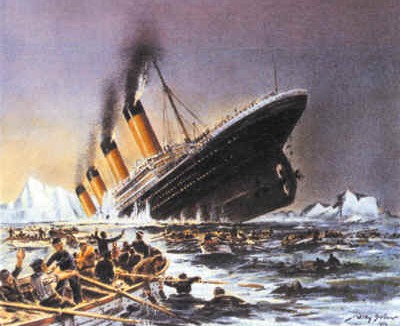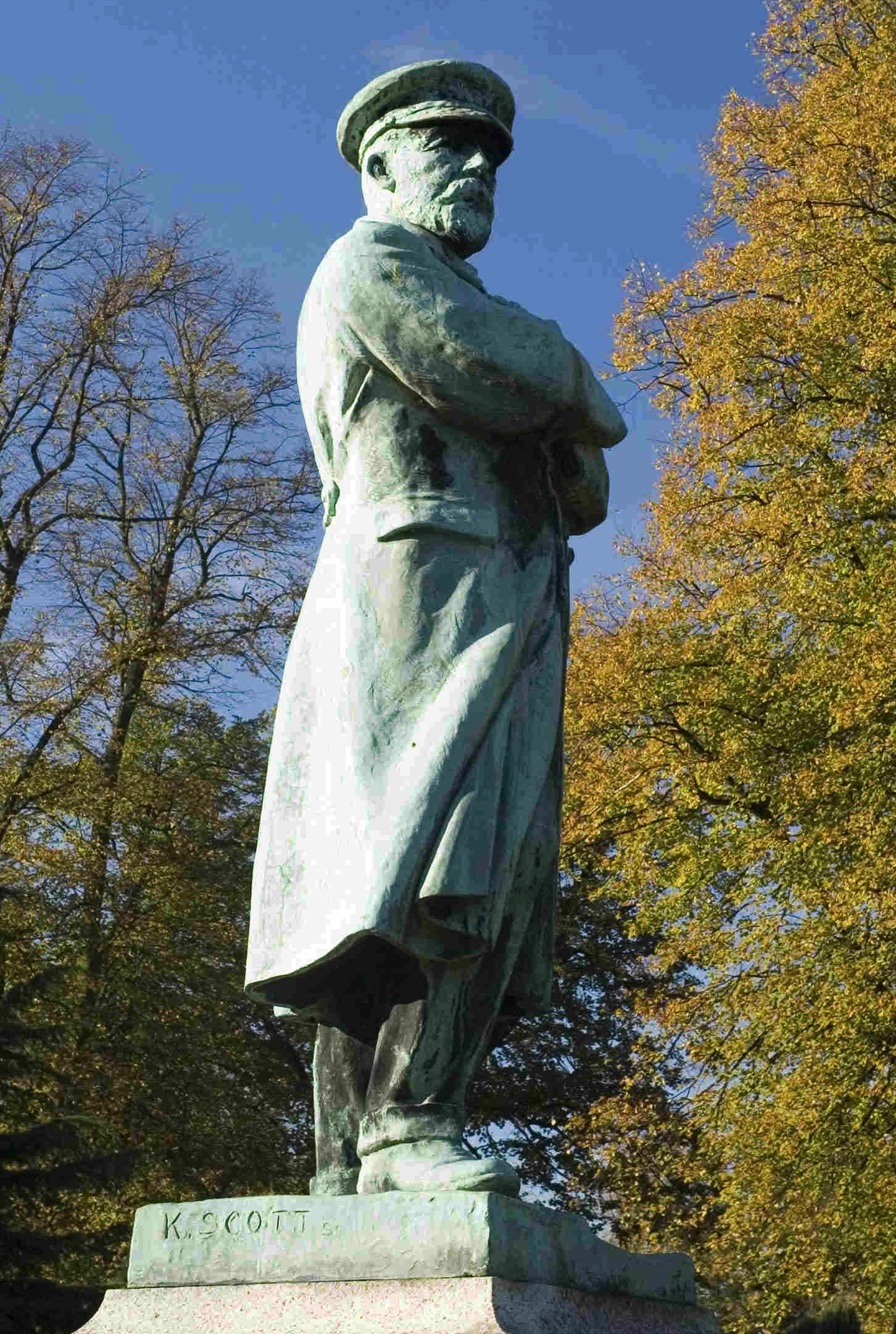| |
Conway & Titanic

Click here to download a paper on the links between HMS Conway & Titanic
Ernie Lee
There
are many stories of nearby vessels that did not come to Titanic's aid.
This member of staff was in SS Benin (Elder Dempster) en route form St
Johns Newfoundland to Cape Town. They were very close to Titanic’s
position but having no radio could not receive her SOS messages. They
only learned of the tragedy on arriving at Cape Town. When they checked
their charts they found they had been “not very far away from Titanic”. |
|
| |
|
Captain Herbert J Haddock, CB, RD, RNR (1875-77)
Captain
Herbert James Haddock was, in fact, the first Captain of the Titanic.
He commanded her build in Belfast before her delivery to the White Star
Line and for some time after delivery but prior to sailing. He was one
of White Star Lines most senior and experienced captains - he had for
some years benne master of "Cedric" then the world's largest vessel. At
the very last minute, on April 1 1912, he was replaced by Captain
Edward John Smith and took command of the Olympic from Smith . He was
at sea in that vessel when the Titanic went down. Captain Haddock
testified to the American inquiry and later also attended the British
Board of Trade inquiry. The White Star Line nearly suffered another
disaster seven weeks after the Titanic went down when Haddock, though
faulty navigation, narrowly avoided running the Olympic onto rocks near
Lands End. For the next few voyages he was closely monitored by a White
Star Line official. Haddock was in command of the Olympic during her
failed effort to rescue HMS Audacious in October 1912.
Olympic was then laid up prior to conversion to a troopship, and the
Admiralty placed Haddock in charge of a dummy fleet of merchant ships,
stationed at Belfast. According to Mills' HMHS Britannic: The Last Titan,
Harold Sanderson tried to have Haddock re-assigned in 1915, to command
the Britannic when she entered service as a hospital ship, but could
not succeed in convincing the Admiralty to release Haddock from his
Belfast duties. Haddock is thought not to have rejoined White Star
after the war. He was awarded the CB in 1902, and made ADC to HM The
King in 1915. He died in 1946.
|
|
| |
|
J. Bruce Ismay
Chairman
and Managing Director of the White Star Line. He sailed on Titanic’s
maiden voyage and, controversially, survived the disaster. He was a
long standing member of Conway's Management Committee as White Star
Line had been one of Conways original sponsors.
|
|
| |
|
C W Lightoller
Just for the record, Titanic's 2nd Officer was not the Cadet W Lightoller who attended Conway 1883 to 1884.
|
|
| |
|
H G Lowe
Just
for the record, Titanic's 5th Officer was not the H G Lowe who attended
Conway in 1910. The Titanic's was Harold Godfrey, ours was Horace
Grenville W. Nor was he Cadet A Lowe (1884 to 1886), Cadet W F D Lowe
(1890 to 1892), or Cadet A D W Lowe (1910) .
|
|
| |
|
James Moody (1902-03)
14th
April 1912 was The Night To Remember. The unsinkable Titanic struck an
iceberg and sank with huge loss of life. The 6th Officer of the Titanic
was James Moody six years out of Conway. Doubtless he would have been
amazed at his good fortune to gain a berth in this, the most
prestigious liner in a most prestigious shipping company. He was on
watch on the bridge at the time of the sinking. He received the fateful
message from the lookouts that there was an iceberg ahead - he had
earlier told them to be on special lookout for them; and initiated the
first avoiding action. When it became clear that Titanic would founder
he was dispatched with the other officers to organise the lifeboats.
5th officer Harold Godfrey Lowe had an encounter with Moody while they
filled boats 14 and 16. Lowe remarked that he had seen five boats
lowered, and one of the next two ought to have an officer. He suggested
Moody as the junior officer should go but Moody answered, “You go. I
will get in another boat” Lowe survived, Moody did not. Moody’s final
actions were recalled by Geoffrey Marcus in The Maiden Voyage. “Chief
Officer Wilde’s efforts to avert panic, maintain order and discipline,
and get the last of the boats loaded and lowered to the water were
valiantly supported by the youngest of the officers, James Moody. Long
before this, the latter should by rights have gone away in one of the
boats along with the other junior officers. But the seamen left on
board were all too few as it was for the work that had to be done.
Moody therefore stayed with the ship to the end and was the means of
saving many a life that would otherwise have been lost.” After
overseeing the safe loading of a number of lifeboats, he was last seen
alone on deck.
There is a rose marble memorial plaque
bearing James's name in the Church of St. Martin on the Hill, Scarborough.
It bears the verse:
'Be Thou Faithful Unto Death and I Will
Give to Thee a Crown of Life." There is also an altar set at St.
Augustine's Church in Grimsby that is memory of James.
There is an additional monument to James
Moody in Woodland cemetery, Scarborough, the existence of which was
known only to a few members of the Moody family. The headstone refers
to his role in the Titanic disaster, and commemorates Moody's sacrifice
with the words 'Greater love hath no man than this, that a man lay down
his life for his friends.' It was long forgotten but a recent article
in the Yorkshire Post (see Bibliography) highlighted the poor condition
of the memorial. It was badly overgrown and the commemorative cross
had been broken off.
Also see the Friends
of HMS Conway section for more information.
His
family donated the Moody Cup, a sailing cup to be competed for annually
by Conway cadets. It is on display in the Merseyside Maritime Museum at
Liverpool. Old Conways keep his memory alive as once a year it is
loaned to the Conway Club Sailing Association where it is awarded for
the best sailing log of the year.
|
|
| |
|
Sir Arthur Henry Rostron CBE KBE RD RNR (1885-6)
Arthur Rostron was
born in Astley Bridge, Bolton, England to James and Nancy Rostron. Educated
at the Bolton School from 1882 to 1883 and the Astley Bridge High School,
Rostron joined Conway at the age of thirteen. After two years of training,
he was apprenticed to the Waverley Line of Messrs, Williamson, Milligan.
He joined Cunard in 1895.
He is best known as the Master of Carpathia
and rescuer of nearly 700 Titanic survivors on the morning of April
15th 1912. As
the result of his efforts to reach the Titanic before it sank, and his
preparations for and conduct of the rescue of the survivors, Captain
Rostron was lionized as a hero. Rostron testified about the events the
night Titanic sank at both the U.S. Senate inquiry and the British Board
of Trade's inquiry into the disaster. Titanic survivors, including Margaret
Brown, presented Rostron with a silver cup and gold medal for his efforts
the night Titanic sank. He went on to become Master of Mauretania
and holder of the Blue Ribband for the west-east Atlantic crossing. After World
War I was appointed Knight Commander of the Order of the British Empire.
He was made the commodore of the Cunard fleet before retiring in 1931. There is a very complete life on
http://www.encyclopedia-titanica.org (type Rostron in search box).
Captain Rostron is incorrectly stated in
many books to have been awarded the Congressional Medal of Honor. The
error is found even in works by American authors, whom one hopes would
be more familiar with their nation's highest military award. In fact,
Rostron was not eligible for the award, nor had he done anything worthy
of it. The Congressional Medal of Honor is reserved for persons of any
nationality serving in the armed forces of the United States. What Captain
Rostron received was a Congressional Gold Medal. This award dates from
1776 and the first recipient was George Washington. Each medal is awarded
by its own individual Act of Congress and must be ratified by the President.
Early medals were generally awarded for military valour, but after the
establishment of the Congressional Medal of Honor in 1865, the award
was extended to all manner of persons recognised as worthy. Recipients
are as varied as Thomas Edison, Walt Disney, Aaron Copland, Nelson Mandela
and Frank Sinatra. The medals are of solid gold and bear on the obverse
an image of the recipient. The reverse contains an image related to
the action that merited the award. Rostron's medal was designed by John
Flanagan, an American sculptor. Captain Rostron's award was proposed
in the Senate on 28 May 1912 and was approved by a Joint Resolution
of both Houses of Congress on 6 July. He was not the first British captain
to be so honoured. That distinction belongs to Captain Creighton, who
in 1866 was recognised for his role in the rescue of some 500 people
from the wreck of the American steamer San Francisco. By the time he
published his memoirs in 1931, Rostron was referring to his award as
the Congressional Medal of Honour (sic) and this is probably the origin
of the confusion. President William
Taft presented Sir Arthur's Gold medal on March 1st 1913 at the White
House. (Taft had lost the 1912 election but in those days the outgoing
President did not retire until March 4th).
Captain Rostron was also awarded the American
Cross of Honor. This decoration was given by the Society of the American
Cross of Honor, an organisation devoted to recognising bravery in the
saving of life in non-military situations. The medal was frequently
awarded for rescues at sea. There was also British involvement and the
gold version of the decoration was sometimes awarded on the recommendation
of the Royal National Lifeboat Institution. This is probably the reason
for the medal being presented to Captain Rostron at the British Embassy,
also on March 1st 1913. He
was also awarded a medal from the Liverpool Shipwreck and Humane Society
and a gold medal from the Shipwreck Society of New York.
|
|
| |
|
William Russell-Smith (51-53)
William was the
grandson of Titanic's Captain E J Smith whose statue was commissioned
by his home town before Titanic sailed. After the loss they refused to
take it but the people of Lichfield ,Staffordshire wanted a statue for their new park so they took it instead. It stands there still.
William was lost overboard from RFA Wave Commander in the English
Channel on 10th April 1956. The accompanying vessels mounted a
comprehensive search for his body but it was never found. He was that
verssel's Third Officer.
|

|
|
|